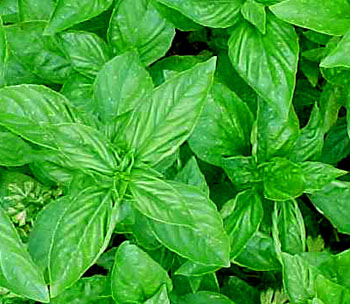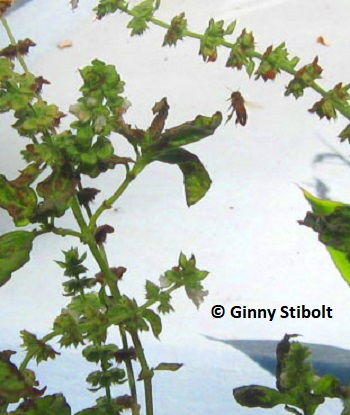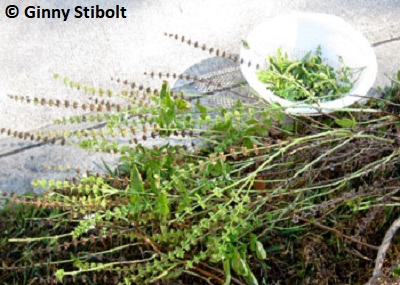|
Adventures of a Transplanted Gardener |
||||
<< A bee hovers around what's left of the basil flowers at the end of the season. Basil flowers arranged in a whorl around the flowering stem, square stems, and opposite leaves tell us that basil is in the mint family. The flowers make an attractive and tasty addition to salads and other dishes. See this link for more on edible flowers. The variety we've grown for the past two years is the large leaf Italian (O. basilicum 'Genovese Gigante'). The taste has some anise overtones, especially at the end of the season. A couple of years ago I grew a dwarf variety with itty-bitty leaves. While it had good flavor and plants were easier to manage, it was a disappointment because you grow basil for its leaves. Throughout the season I've been using generous portions of basil in our salads, soups, and other cooking. I've been pinching it back to keep it growing—when you cut off the top, two new branches sprout from the next node down the stem. In the middle of the summer I made several batches of pesto and froze a few containers for use until next season. As I've described before, my pesto recipe is more like a pesto sauce which differs from the traditional olive oil, pine nuts, and basil. I substitute sunflower seeds for the pine nuts and add onion, horseradish, mayonnaise, Parmesan cheese, and more. To have enough green stuff for my last pesto, I used not only the leaves, but the flowers, buds, and the green seed pods. I skipped the dried seedpods for the pesto, but I harvested some of the seeds for next year. Certainly more than a few seeds dropped on the ground in the last month or two and during the harvest. Some of those self-sown seeds may grow on their own.
Last basil harvest of '08. While there are some leaves, I also harvested the flowers, buds, and green seeds for pesto. I did not harvest the dried seed pods or any stems that were at all woody. >> Support the beesDuring the growing season, I picked off most of the flowering stems to keep the plants bushy, but I did let a few flowers remain because the bees and the butterflies love them. Even after my final fall harvest, I left one plant with lots of flowers, but very few leaves, standing in the garden. It's a little ugly, but we love watching the buzzyness just outside of our dining area. The bees will have it for a while longer before a hard frost totally ends the season. I still have some left over basil seeds stored in a plastic box in the refrigerator. Next spring will be the third year on this package of seeds, so I'd expect a lower germination rate. I'll purchase more seeds in case none sprout and maybe I'll try another variety like purple. That would be fun. If you've never grown herbs before, start with basil to really impress your family with its wonderful aroma and taste. (Note: I rarely use this sweet basil any more because lime basil (Ocimum americanum) does sooo much better in Florida's wet summers. The link leads to two articles I've written about this tough, but delicious basil.) |
||||
|
Ginny Stibolt is a lifelong gardener, a botanist, a naturalist, and a garden writer. You may contact her or read more of her articles posted on her website: www.greengardeningmatters.com. |
||||
Copyright Ginny Stibolt




